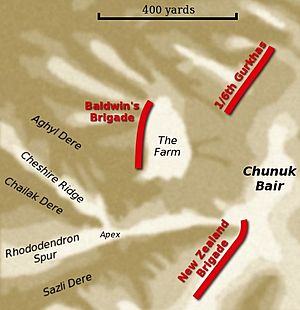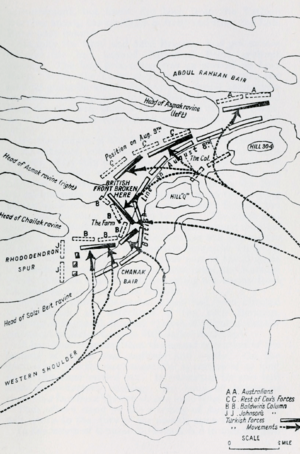Battle of Chunuk Bair facts for kids
Quick facts for kids Battle of Chunuk Bair |
|||||||
|---|---|---|---|---|---|---|---|
| Part of the Gallipoli campaign of World War I | |||||||
 Turkish POWs being escorted in Chunuk Bair |
|||||||
|
|||||||
| Belligerents | |||||||
|
|
||||||
| Commanders and leaders | |||||||
| Strength | |||||||
| 15,000 men | 19th Division 9th Division (20,000–30,000 men) |
||||||
| Casualties and losses | |||||||
| 12,000–13,000 | 9,200 | ||||||
The Battle of Chunuk Bair (Turkish: Conk Bayırı Muharebesi) was an important battle during World War I. It took place in August 1915 between the Ottoman defenders and troops from the British Empire. The fight was for control of Chunuk Bair, a high peak on the Gallipoli peninsula.
Capturing Chunuk Bair was a key goal for the British forces. They hoped it would help them break a difficult situation in the Gallipoli campaign. Although British and New Zealand troops reached the peak for a short time, the Ottomans eventually won the battle and took back control of the hill.
| Top - 0-9 A B C D E F G H I J K L M N O P Q R S T U V W X Y Z |
Why This Battle Happened
The Gallipoli Campaign was stuck. Neither side could make much progress. To try and change this, the British commander, General Ian Hamilton, planned a new attack.
The August Offensive
This new plan, called the August Offensive, aimed to capture the high ground of the Sari Bair Range. This included Chunuk Bair and another peak, Hill 971. Both sides had received more soldiers. The British now had 15 divisions, and the Ottomans had 16 divisions.
The British planned to land new troops at Suvla, north of Anzac Cove. From there, they would advance towards the Sari Bair Range. At the same time, troops already at Anzac would attack the Sari Bair range from the north.
The Anzac Plan
The New Zealand and Australian Division was given the job of attacking the Sari Bair range. This division was made stronger with more soldiers, bringing its total to about 20,000 infantry. The attack would involve different groups of soldiers moving through rough land to reach Chunuk Bair and Hill 971.
Before the main attack, smaller groups had to clear Ottoman outposts. The goal was to reach the main peaks before dawn. Once the peaks were captured, the plan was to dig in and hold the ground.
Ottoman Preparations
The Ottoman commanders didn't expect an attack on Chunuk Bair. They thought the land was too difficult for a large assault. However, Mustafa Kemal, who led the Ottoman 19th Division, believed Chunuk Bair was vulnerable. He tried to convince his leaders to strengthen the defenses, but they didn't do much.
The Battle Begins
Fighting on Rhododendron Spur
The path to Chunuk Bair was along a ridge called Rhododendron Spur. The Ottomans had small outposts along this ridge. These outposts had to be cleared by New Zealand troops before the main attack could go forward.
New Zealand soldiers fought hard to clear these outposts. They faced strong Ottoman defenses with machine guns. The New Zealanders lost about 100 men in this fighting. Even though they succeeded, the attack was now two hours behind schedule. This made it difficult to reach the summit before daylight.
The troops advanced up valleys on either side of the spur. They then climbed onto the ridge, with about 1,000 yards left to the summit. By 4:30 AM, some battalions were close to a spot called "The Apex," which was only about 500 yards from the summit. At this time, there were only about 20 Ottoman soldiers on the peak.
However, the commander, Colonel Johnston, decided to wait for all his battalions to arrive. This went against his orders not to stop. This delay proved costly.
At the same time, a supporting attack was planned at a place called The Nek. This attack was supposed to happen when the New Zealanders attacked Chunuk Bair. Despite the delay at Chunuk Bair, the Battle of the Nek went ahead, leading to many casualties.
Struggle for Chunuk Bair
The chance for a quick victory at Chunuk Bair was lost. As the Ottomans realized the danger, they sent many more soldiers to reinforce the peak. By 7:30 AM, the New Zealanders were still 500 yards from the summit. Ottoman and German reinforcements were arriving quickly.
By 10:00 AM, about 500 Ottoman soldiers were on the peak. Australian artillery observers saw these reinforcements and fired on them, forcing some Ottomans to seek better cover.
With daylight, and facing strong resistance, the New Zealanders' chances of taking the peak seemed small. Colonel Johnston asked to wait until nightfall. But General Godley ordered him to attack anyway.
Two hundred yards beyond the New Zealanders was another small hill called "The Pinnacle." From there, it was a direct climb to the summit.
At 11:00 AM, the Auckland battalion attacked. About 100 soldiers reached The Pinnacle, trying to dig in. Around 300 were wounded or killed between there and The Apex. The Wellington battalion was ordered to continue the attack. However, their commander, Lieutenant Colonel William Malone, refused. He believed it was a hopeless attack and said his battalion would take Chunuk Bair at night.
After two attempts, General Godley finally called off the daytime attack. Hundreds of Allied soldiers lay dead or wounded.
Godley planned another attack for the next day, August 8. He sent more British troops as reinforcements. A 45-minute naval bombardment would start at 3:30 AM, followed by machine gun fire to support the attack.
After the naval bombardment, the Wellington and Gloucester battalions reached Chunuk Bair with little resistance. The shelling had forced most Ottoman defenders away.
Holding Chunuk Bair was difficult. The ground was rocky, making it hard to dig deep trenches. The peak was also exposed to fire from other Ottoman positions.
By 5:00 AM, the Ottomans counter-attacked the Wellingtonians. The hill was so steep that Ottomans could get very close without being seen. The New Zealanders fought fiercely. When the Ottomans reached the trenches, the fighting continued with bayonets. The Ottomans took part of the New Zealand trench and some prisoners.
The fighting lasted all day. Around 5:00 PM, Colonel Malone was killed by an artillery shell, possibly from his own side.
The Ottomans recaptured the east side of the summit. As the full scale of the Allied attack became clear, General Otto Liman von Sanders, the Ottoman commander, put Mustafa Kemal in charge of defending the area.
As darkness fell on August 8, the fighting stopped. The Wellington Battalion was relieved. Out of 760 men who reached the summit, 711 were killed or wounded. Other British battalions also suffered heavy losses.
The Final Ottoman Counter-attack
General Godley, still at his headquarters, planned to take Hill Q on August 9. This attack also failed, as the British battalions got lost in the dark. Only a Gurkha battalion briefly reached Hill Q but was shelled by their own artillery and had to leave.
The New Zealanders on Chunuk Bair faced another day of Ottoman attacks. That night, they were replaced by two new British battalions.
On the morning of August 10, Mustafa Kemal led a massive Ottoman counter-attack. He planned to overwhelm the defenders with sheer numbers. There were about 2,000 Allied defenders on or near the summit.
The Ottomans swept over the British Lancashire battalion on the summit, with few survivors. Other British troops were scattered. The Ottomans also captured The Pinnacle. New Zealand machine gunners at The Apex fired on the charging Ottomans, killing many, including some Allied soldiers caught in the rush.
On the north side of Rhododendron Spur, the Ottomans attacked a plateau called The Farm. They overran a British brigade there, causing huge losses. The Ottoman infantry were exhausted and fell back to the main ridge. The Farm became a "no man's land" between the two sides.
What Happened After
Casualties
The battle was very costly for both sides. The Ottomans had about 9,200 casualties (killed, wounded, or missing) at Chunuk Bair and Hill 971. The total Ottoman casualties at Anzac were around 18,000 men. British casualties were between 12,000 and 13,000 men.
Remembering the Battle
Memorials
A memorial arch, the Malone Memorial Gate, was built in Stratford, New Zealand in 1923 to honor Lieutenant-Colonel Malone. A memorial to New Zealand soldiers who died in the campaign was unveiled on Chunuk Bair in May 1925.
Victoria Cross
Only one Victoria Cross, the highest military award for bravery, was given for actions at Chunuk Bair. It went to Corporal Cyril Bassett, who bravely repaired phone lines while under enemy fire.
Images for kids







